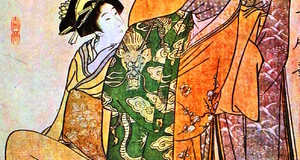Featured Article:Women in Meiji Japan: Exploring the Underclass of Japanese IndustrializationThese poor conditions and standards of living may, no doubt seem much worse to us from the point of view of a 21st century “intellectual” than it did to the girls themselves. It is true that most of the girls who went back to their villages after retiring as old women seldom reported any shortcomings of their factory life. In fact, most of them recounted those days with pride, as a service to Japan. But it is also undeniable that many ran away and committed suicide. Misiko Hane offers light in the same context, “A weeding out process had already taken place. These people had survived the “ordeal.” Many who were less hardy had fallen by the wayside, dying of tuberculosis or even committing suicide.”11 This should not however, present an image of the lack of agency amongst these women to talk of their hardships during their time at the factory. It would be our ignorance, much like that of the mill-owners’ at the time, that these were simple women from the countryside; who had no scholarly or artistic capabilities. On the contrary, these women workers were more than just literate. And thus, most of the understanding of their conditions comes from the poetry, which they wrote in their dormitories and the paens they sang together. One of these verses reads,
Another song they would sing went like this:
The second largest employer of women in Meiji Japan after the textile industries was the brothel. Prostitution had a long history in Japan before the Meiji restoration took place. After finding no legal space in the Tokugawa era, prostitution was legalized by the Meiji reformists. This now meant that young women could be legally bought and sold into prostitution—both within Japan and overseas to Korea, China and Southeast Asia. Many families owing to poverty, famine and crop failure often sold poor farm girls to brothels. But the stigma attached to the profession led the public to assume that the prostitutes chose this way of life themselves. The “other” side of the story was hardly known by the masses in Japan.14 Even in this period, like before, most people considered prostitutes to be less than human. Although there were people who were aware of the conditions of poverty that forced women into prostitution, most of them found it easier to blame the victim rather than society. In most major cities, sections were given up as red light districts. Here, the prostitutes were displayed as if they were standing in a slave market, ready to be sold to the highest bidder. (Hane)In 1883, there were 3,156 registered prostitutes in about 400 red light districts in Japan. This shot up to 4,747 in 1887 and 6,834 in 1909. Since abortion and infanticide15 had been criminalized by the Meiji regime, the poor farmers countered a rise in the number of children in the family by selling the daughters off to the brothels. This was also perpetuated, in some ways, by the lack of information about birth control. These brothels came up mostly in urban areas and thus, led to further expansion of the urban space; they were mostly located on the outskirts of the cities and hence catalyzed the cartographic swelling up of the cities. Let this not mean, however, that females grew in number in the cities. It has been seen throughout the globe, that wherever industrialization has taken place, a hugely disproportionate sex ratio has existed in the factory areas. Tanika Chakraborty argues,
In Tokyo prefecture, for example, men outstripped women by approximately 130,000. This disproportion has always led to a need for sex trade as a necessity for these workingmen, who are deprived of any contact with the opposite sex. Hence, the fast industrial growth saw an increase in the brothels. Due to the long tradition of brothels in medieval Japan, it was not completely immoral for a “lustful man” to visit one occasionally. Thus, by 1904, there were 43,134 prostitutes in public brothels, and in the next two decades, this number shot up to 52,325. A direct relation has also been observed in terms of crop failure and famine and the selling of daughters into prostitution. The years that saw famines and low production on the farm were also the years when the maximum number of girls was sold to public brothels17. In most public brothels many girls, who had not yet gone through puberty, had to take customers. What is even harsher to hear is that most of them did not even know what they were stepping into while being sold off, as many of them later reflected in their memoirs or interviews. Meanwhile, as Japanese activities in Korea and Manchuria intensified, a large number of brothels began springing up in these areas as well. They were supplied with the same source of prostitutes—the poor peasant families’ daughters—and estimates say that about over 30,000 prostitutes were brought to Manchuria alone by the Japanese. In countries like Korea, Japan introduced the concept of a brothel by supplying a huge contingent of its prostitutes; most of who had no idea where and why they were going. Later, when the Japanese went westwards into Asia during the Second World War, they took along with them brothels. A large contingent of sex slaves marched alongside the frontline battalions of the Japanese Army. Many of these women were left for dead once the War was over; but a large number of them survived. Their stories came into the mainstream discourse many years later in the 1960s and 1970s, as news journalists began to uncover them. They continued to live traumatic lives in the countries that they “served” in. They are not the quintessential war veterans in the eyes of the state, despite being at the front lines. Politically, there was little resistance to public brothels as most of the scholars and politicians chose to ignore this aspect.18 However, there were the likes of Tsuda Mamichi, Shimada Saburo19, Yamamuro Gunpei20, Yamada Waka21 and many of the Christian missionaries who took up reform for the prostitutes as a key agenda. The medium used was mainly newspaper articles, tracts and speeches. There role is discussed further below. In the political sphere, there was little space for women. This does not mean that the state’s efforts of nation building excluded the women. However, the role that they decided for women, as we have seen so far, was far from liberating. The state-sponsored education system worked as a key propaganda tool of the Meiji regime in gendering the citizens of Meiji Japan. Along with the Home Ministry and the various legislations, the twin ideals of “good wife, wise mother” (ryosaikenbo) were popularized in the 1890s. But these were meant only for the middle class women—labor of the low class women was required for the factory (Tipton). For the lower class women, it was the ‘cult of productivity’ rather than the ‘cult of domesticity’22 that was propagated. This is a classic example of how ideology functions in Asian capitalist society, creating a rather perpetual labor force by exploiting a certain class; using the ideological craft of the dominant class. The ideals of modesty, frugality and purity were encouraged by the state among upper and middle class women. The primary role of a woman was restricted to the “kitchen.” So much so, that a law in 1890 prevented female participation in any political meeting or political organization. The traditional patriarchal idea of the woman as the home-maker was sustained in Japan despite its great culture of debate and dialogue. They fell for the Eurocentric-patriarchal potholes in the new ideas that they embraced so readily. Schools for girls offered as a socializing agent for this agenda of the state. The aim of these schools was to produce young women of refined taste and modest character. They were made to study less academic subjects and focused on domestic-skill learning. This however, as mentioned earlier was only for the middle class and upper class women. The lower classes were brainwashed into spending their lives in labor for the factory.Continued on Next Page » Suggested Reading from Inquiries Journal
Inquiries Journal provides undergraduate and graduate students around the world a platform for the wide dissemination of academic work over a range of core disciplines. Representing the work of students from hundreds of institutions around the globe, Inquiries Journal's large database of academic articles is completely free. Learn more | Blog | Submit Latest in History |


















